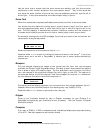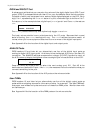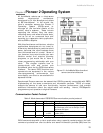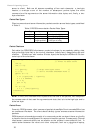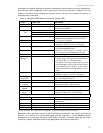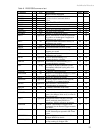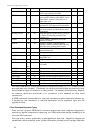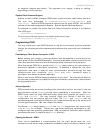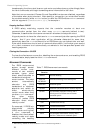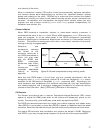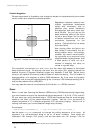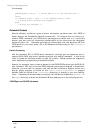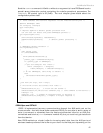ActivMedia Robotics
for negative integers; see below). The argument is an integer, a string, or nothing,
depending on the command.
Saphira Client Command Support
Saphira, as well as ARIA, all support P2OS client commands with useful library functions.
You can find prototypes in $(SAPHIRA)/handler/include/saphira.h and
saphira.pro. Saphira’s P2OS command names have the prefix sfCOM. Not all P2OS
command names are supported in Saphira. See the Saphira Software Manual.
For example, to enable the motors from the Colbert interaction window in the Saphira
client GUI, type:
sfRobotComInt(sfCOMENABLE,1);
Or to have your Pioneer 2 play a tune (albeit rather tinny), type:
sfRobotComStrn(sfCOMSAY,"\1\6\2\105",4);
Programming P2OS
You may create your own P2OS interface, or use the convenience functions available
through the various applications-development software that come with your ActivMedia
robot.
Establishing a Client-Server Connection—SYNC
Before exerting any control, a client application must first establish a connection to the
robot server via the Host RS-232 serial port. Over that established communication link, the
client then sends commands to and receives operating information from the server.
When first started, P2OS is in a special wait (“noconn”) state, listening for communication
packets to establish a client-server connection. To establish a connection, the client
application must send a series of three synchronization packets through the Host
communication port, containing SYNC0, SYNC1, and SYNC2 command bytes, in
succession, and retrieve the server responses.
When in wait mode, P2OS echoes packets back to the client. The client should listen for
the returned packets and only issue the next synchronization packet after it has received
the appropriate echo.
Autoconfiguration
P2OS automatically sends robot-configuration information back to the client in the last
synchronization packet (SYNC2) echoed when establishing a connection. After the
SYNC2 byte, there are three NULL-terminated strings that comprise the robot’s name,
class, and subclass. You may uniquely name your Pioneer 2 with the p2oscf
configuration tool we provide with the robot. The class and subclass also are
parameters stored in the robot's FLASH, but are constants normally set at the factory and
not changed thereafter. (See next chapter for details.)
The Pioneer class string is simply Pioneer; the subclass depends on your robot model;
P2DX or P2AT, for example. Clients may use these identifying parameters to self-
configure their own operating parameters. ARIA, for instance, loads the robot’s related
parameters file found in a special robot params directory.
Opening the Servers—OPEN
Once you’ve established a communication link, the client should send the OPEN
command to the server, which causes the ActivMedia robot controller to perform a few
35



